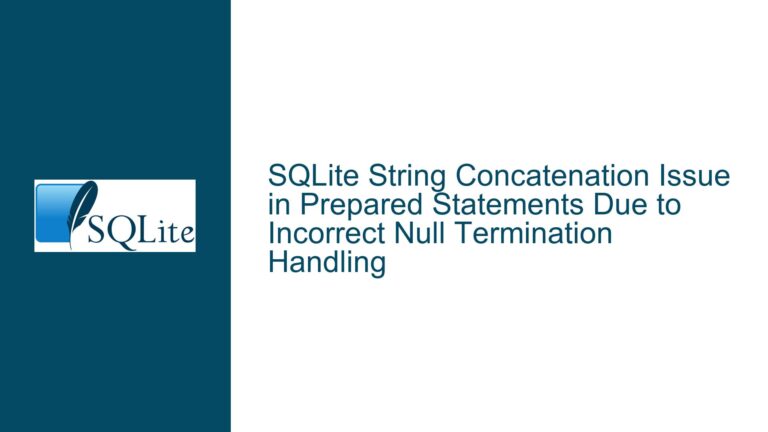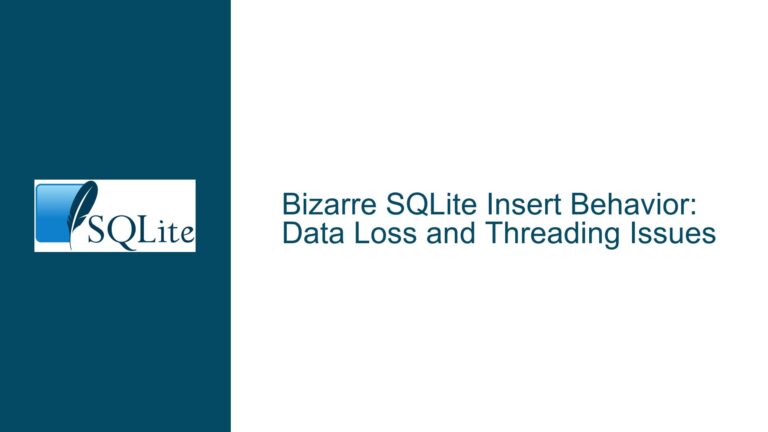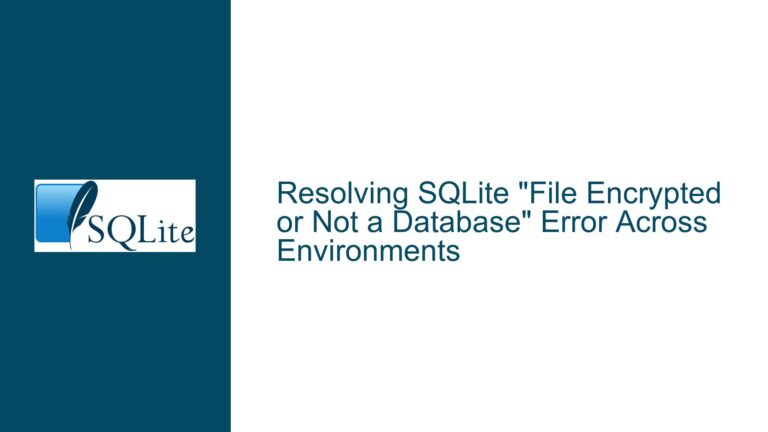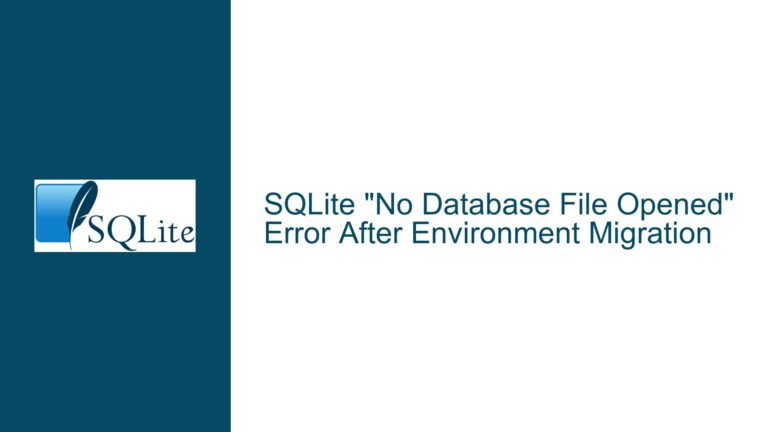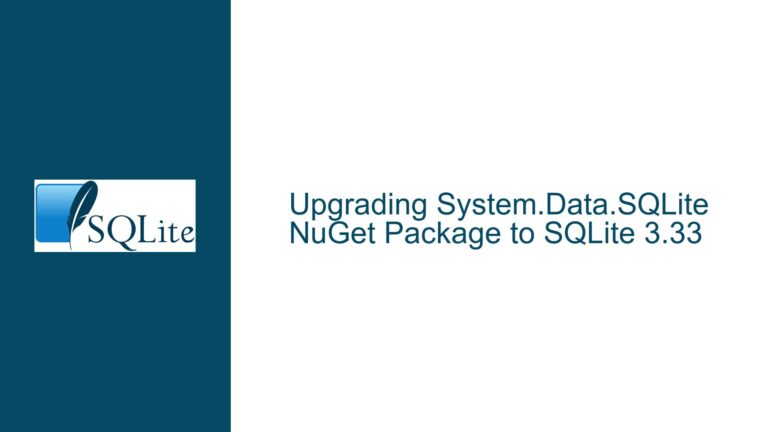Resolving SQLite Zombie Connections and Missing sqlite3_busy_handler Export
Understanding Zombie Connections and sqlite3_busy_handler Dependency in SQLite
SQLite’s lightweight architecture and file-based database model make it a popular choice for applications requiring low-overhead data storage. However, its concurrency model and resource cleanup mechanisms can lead to subtle issues when connections are mismanaged. A recurring problem involves "zombie" native connections that remain active even after managed objects like SQLiteConnection are closed. This issue is exacerbated when the sqlite3_busy_handler API – a critical tool for customizing busy timeout behavior – is no longer exported in newer versions of libraries like SQLite.Interop.dll. This guide dissects the root causes of zombie connections, explains the role of sqlite3_busy_handler, and provides actionable solutions to resolve these problems.
Connection Cleanup Failures and Busy Handler Reliance
The Zombie Connection Phenomenon
Zombie connections occur when the native SQLite database handle (of type sqlite3*) remains open despite the managed SQLiteConnection object being closed. This happens due to deferred cleanup mechanisms introduced in SQLite’s sqlite3_close_v2 function, which allows the database connection to close only after all associated statements (sqlite3_stmt* objects) and other resources are fully released. If pending statements or unfinalized objects exist when SQLiteConnection.Close() is called, the native connection enters a "zombie" state, blocking subsequent operations until garbage collection (GC) cleans up the remaining managed objects. This creates a race condition where the GC’s non-deterministic finalization may not occur quickly enough, leading to timeouts or database locks.
The Role of sqlite3_busy_handler
The sqlite3_busy_handler function allows developers to define custom logic when a database operation encounters a SQLITE_BUSY error, typically due to concurrent access. By intercepting this error, applications can implement retries, force resource cleanup, or trigger GC to resolve zombie connections. However, when this function is not exported by the SQLite interop layer (e.g., in System.Data.SQLite 1.0.82+), developers lose the ability to handle busy states programmatically, forcing reliance on default timeout behaviors that may not address underlying resource leaks.
Managed Layer Limitations
The System.Data.SQLite library abstracts native SQLite functions into managed classes like SQLiteCommand and SQLiteDataReader. While this simplifies development, it introduces complexity in resource management. For example, undisposed SQLiteDataReader objects keep native statements alive, preventing the connection from closing fully. Even when developers explicitly call Close() on connections, lingering references to statements in the finalization queue can delay native cleanup, especially in long-running applications with infrequent GC cycles.
Root Causes of Zombie Connections and Handler Unavailability
1. sqlite3_close_v2 and Deferred Cleanup
The shift from sqlite3_close to sqlite3_close_v2 in modern SQLite builds changed how connections are closed. Unlike sqlite3_close, which immediately returns SQLITE_BUSY if statements are pending, sqlite3_close_v2 defers closure until all statements are finalized. While this prevents data corruption, it creates zombie connections if the managed layer does not aggressively dispose of statements. This is common in applications that rely on IDataReader implementations without explicit disposal or in cases where exceptions bypass using blocks.
2. Improper Disposal of Managed Objects
SQLiteCommand and SQLiteDataReader instances that are not disposed properly retain references to native statements. For example:
using (var connection = new SQLiteConnection("Data Source=test.db"))
{
connection.Open();
var command = new SQLiteCommand("SELECT * FROM table", connection);
var reader = command.ExecuteReader();
// Missing reader.Dispose() or command.Dispose()
}
Here, the undisposed reader keeps the native statement active, forcing the connection into a zombie state after Close() is called.
3. Garbage Collection Delays
.NET’s GC operates non-deterministically, meaning finalizers for undisposed managed objects may not run immediately. If a SQLiteDataReader is garbage-collected minutes after its parent connection is closed, the native statement remains active during that interval, blocking the database. This is particularly problematic in applications with high memory allocation rates, where GC pressure delays finalization.
4. Absence of sqlite3_busy_handler in Managed API
The System.Data.SQLite wrapper historically allowed direct access to sqlite3_busy_handler via P/Invoke. However, newer versions omit this export, likely to enforce managed API patterns. Without this function, developers cannot implement custom busy handlers to force GC or retry logic during SQLITE_BUSY errors, leaving them dependent on the default 30-second timeout.
Resolving Zombie Connections and Busy Handler Alternatives
Step 1: Enforce Strict Object Disposal
Ensure all SQLiteCommand, SQLiteDataReader, and SQLiteTransaction objects are disposed explicitly. Avoid relying on finalizers by using using blocks:
using (var connection = new SQLiteConnection("Data Source=test.db"))
{
connection.Open();
using (var command = new SQLiteCommand("SELECT * FROM table", connection))
using (var reader = command.ExecuteReader())
{
// Process data
} // reader and command are disposed here
} // Connection is closed and disposed
For asynchronous code, pair await using with IAsyncDisposable where supported.
Step 2: Leverage the Managed Busy Event
In System.Data.SQLite 1.0.82+, use the SQLiteConnection.Busy event as a managed alternative to sqlite3_busy_handler:
var connection = new SQLiteConnection("Data Source=test.db");
connection.Busy += (sender, args) =>
{
// Trigger GC to finalize pending objects
GC.Collect();
GC.WaitForPendingFinalizers();
args.Retry = true; // Retry the operation
};
This event fires during SQLITE_BUSY errors, allowing custom retry logic without native interop.
Step 3: Tune Garbage Collection
Reduce GC finalization delays by:
- Forcing GC after critical operations:
connection.Close(); GC.Collect(); GC.WaitForPendingFinalizers();This ensures pending statements are finalized before proceeding.
- Using
GC.KeepAlive: Prevent aggressive GC from collecting objects prematurely in long-running methods. - Configuring the GC mode: Use server GC (
<gcServer enabled="true"/>) or low-latency modes to prioritize timely finalization.
Step 4: Enable Connection Pooling
SQLite’s default connection pooling reuses native handles, reducing the overhead of frequent opens/closes. Configure pooling parameters in the connection string:
"Data Source=test.db;Pooling=True;Max Pool Size=100"
Pooling minimizes zombie connections by recycling handles instead of closing them, though it requires careful management to avoid statement leaks.
Step 5: Audit for Undisposed Objects
Use diagnostic tools to identify undisposed objects:
- Memory Profilers: Tools like JetBrains dotMemory or Visual Studio’s Diagnostic Tools can track
SQLiteCommand/SQLiteDataReaderinstances. - Finalization Logging: Override finalizers to log undisposed objects:
public class SafeSQLiteDataReader : SQLiteDataReader { ~SafeSQLiteDataReader() { Logger.LogWarning("Undisposed SQLiteDataReader detected!"); } }
Step 6: Downgrade or Custom Build the Interop Library
If dependency on sqlite3_busy_handler is unavoidable:
- Downgrade to Pre-1.0.82 Versions: Use older
System.Data.SQLitebuilds where the handler is exported. - Compile a Custom Interop DLL: Rebuild
SQLite.Interop.dllwith theSQLITE_ENABLE_API_ARMORflag disabled to restore the missing exports.
Step 7: Monitor Open Connections
Implement runtime checks to detect zombie connections:
public static void AssertNoOpenConnections()
{
var field = typeof(SQLiteConnection).GetField("_connections", BindingFlags.Static | BindingFlags.NonPublic);
var connections = (Hashtable)field.GetValue(null);
if (connections.Count > 0)
{
throw new InvalidOperationException($"{connections.Count} zombie connections detected!");
}
}
Call this method after critical operations to catch leaks early.
Step 8: Adopt Transactional Best Practices
Wrap operations in transactions to minimize lock contention:
using (var transaction = connection.BeginTransaction())
{
try
{
// Execute commands
transaction.Commit();
}
catch
{
transaction.Rollback();
throw;
}
}
Transactions reduce the window for SQLITE_BUSY errors by serializing access.
By addressing resource disposal, leveraging managed events, and tuning garbage collection, developers can mitigate zombie connections without relying on sqlite3_busy_handler. For legacy systems requiring the native handler, custom builds or downgrades remain viable, albeit less maintainable, solutions.

